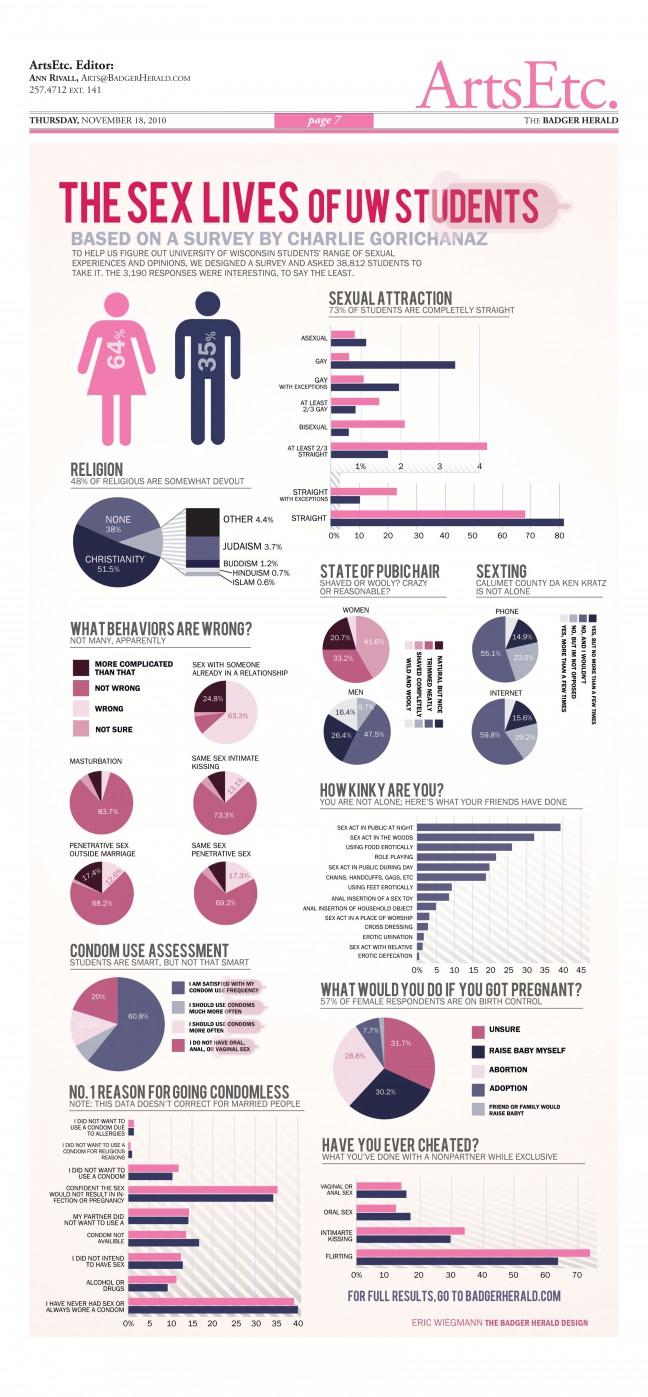Badgers are a quirky bunch. For a group that’s half Christian and of which more than a fifth have possibly never experienced an orgasm, a surprisingly high number have used food erotically and had sex with relatives.
Or maybe this is not that weird. Perhaps this is just human nature, but either way, it’s interesting.
Yesterday we published some of the results (.pdf) of a Badger Herald survey designed by yours truly. I glossed over the methodology in that column, which focused on sexually transmitted diseases. Here I will explain those results and many others in more detail.
Methods
This was not a scientifically robust survey, but efforts were made to make the sample as representative as possible and make the questions as statistically useful as possible given our limitations.
We sent a link to the comprehensive sexual health survey to the 38,812 students for whom we could obtain e-mail addresses through a request to the University of Wisconsin-Madison Bursar’s Office. This encompassed more than 92 percent of UW students based on the wisc.edu admissions web page quick facts. Each student received a unique, randomly generated code that was required on the survey launch page, which marked the code as used in a database and allowed the user to proceed to the survey. Students were assured all survey pages would be served over an encrypted, secure connection. It is impossible for anyone to correlate survey results with the code used to enter the survey, so the results are therefore anonymous.
The first e-mail was sent to students Oct. 1, and a reminder e-mail was sent Oct. 14. Students had until the end of the day Oct. 19 to take the survey.
As an incentive, we put up five $20 prizes, a $150 prize and four Deadmau5 concert ticket prizes. And for that we received 3,190 valid responses.
We believe the sampling method resulted in a reasonably representative sample. The selection method was convenience based, but only less than 8 percent of students were not able to take the survey. Perhaps a correlation exists between extremely privacy conscious students and sexual appetite, but we doubt it is a strong one and have not seen studies indicating otherwise. Additionally, sexually conservative students may have been less likely to open an e-mail with “sexual health survey” in the subject line. Likewise, the promiscuous among us may have been keen to read such an e-mail and complete the survey. Without having a way to determine the sizes of those two populations, we cannot be sure if the collective effect of the two hypothetical problems actually skewed the data in any way. We do not have reason to believe these had a significant effect, though, and we hope the incentive minimized the error in the conclusions.
Note: Participants were able to answer as many or as few questions as they desired. We decided the extra data we would obtain for allowing partial surveys would make up for the statistical problems involved with analyzing questions that an unknown number of people might have answered a certain way.
At the survey conclusion, we began analyzing the data. First we removed all data sets that contained an extremely unreasonable value for one of the questions. Remarkably, this only resulted in 10 discarded surveys. Then we combed the numeric answers for unreasonable results, which were flagged for further analysis. Judging by the other responses from the same user, it was determined none of the unreasonable values warranted discarding the entire survey result set. We chose to instead exclude the unreasonable responses for that particular question but still use the rest of the responses from that user. We also excluded the more sensitive responses from the five respondents who said they were not at all comfortable taking the survey as determined by the first question. After those exclusions, for the questions asking about numbers of occurrences of a particular scenario or act, the highest 1 percent of responses was also excluded from analysis.
For the following results, if the number of participants who indicated they preferred not to answer a specific question is not specified, it can be assumed the reported percentages are based on the number of responses to the other options. For example, 0.31 percent of respondents said they preferred not to indicate what grade they are in. While 19.92 percent of the responses to that question were “Undergraduate, first year,” we are reporting a 19.98 percent response rate for that option after excluding those who preferred not to answer. This almost always was a minor difference.
If a question set up in a way that did not explicitly allow participants to state it did not apply to them, the resulting percentage must be interpreted as “at least X percent.” For example, one of the questions asked participants to check boxes for websites they had used in the past to meet someone with whom they later had sex. We cannot control for users who read the question and decided it did not apply, and users who skipped the question entirely but to whom the response may have applied. We therefore divide the 111 responses for “Facebook” by the 3,190 possible responses to mean at least 3.5 percent of respondents had used Facebook to meet someone with whom they later copulated.
We have not calculated margin of error. Very small reported percentages will be generally less reliable than larger reported percentages. Especially since the surveys were voluntary, and we cannot ensure accuracy of responses, none of the following statistics is to be taken as a claim of actual representation or fact.
Finally, results are reported with all genders combined generally, but males and females are calculated and reported separately in cases where the distinction shows significant differences.
Demographics
Gender: Females were more likely to take the survey than males. According to the UW-Madison website, in fall 2009 the studentry was composed of 48.2 percent males and 51.8 percent females. The survey participants were 35.3 percent male, 64.5 percent female, and 0.25 percent reported being transgendered.
Age: The average age reported was 21.7 years, with the following groups: Two were 17, 202 were 18, 557 were 19, 508 were 20, 529 were 21, 383 were 22, 297 were 23, 139 were 24, 113 were 25, 76 were 26, 73 were 27, 45 were 28, 42 were 29, 29 were 30, 71 were 31 to 40, 19 were 41 to 50 and three were 51 to 55. See Figure 1.
Year: The grade level breakdown for undergraduates was as follows: 20.0 percent first year, 17.0 percent second year, 16.2 percent third year, 15.8 percent fourth year and 6.9 percent fifth year or more. Additionally, 24.1 percent of respondents said they are graduate, professional or other students.
Environment: Most UW students grew up in a suburban area, as 22.4 percent said they spent most of their childhood years in a rural area and 17.5 percent said urban. When asked about the last six years, the responses were 12.1 percent rural, 43.4 percent suburban and 44.5 percent urban. We did not define these terms, as we were just aiming for a general idea and did not want to complicate the survey too much.
Religious classification: A majority of UW students surveyed, at 50.7 percent, practice a form of Christianity. Judaism was claimed by 3.6 percent, while 1.2 percent practice Buddhism, 0.7 percent Hinduism and 0.6 percent Islam. Then another 4.3 percent said they practice another religion. The group of nonreligious students was 37.4 percent of the total. Of the nonreligious, 60 percent said they are agnostic and the rest atheist. See Figure 2.
Religious devotion: Only 12.0 percent of religious students said they considered themselves to be very devout, and 36.1 percent said somewhat devout. Another 23.7 percent said they are not very devout, and 28.3 percent said they are not at all devout but still consider themselves to be religious.
Race: Only 5.2 percent of respondents said they are of Hispanic or Latino origin. If you know Madison, then you won’t be surprised 89.2 percent of respondents said they are white. Then 7.8 percent said Asian, 2.3 percent black or African American, 1.4 percent American Indian or Alaskan native, 0.4 percent Native Hawaiian or other Pacific islander and 2.8 percent some other race.
Medication
The second question was: “Some medications, especially common antidepressants like Prozac and Zoloft, are associated with sexual side effects that can include complete inhibition of sexual desire. Are you currently taking any such medications”? To this, 7.0 percent answered in the affirmative, 0.8 percent said they sometimes take such medication, 0.6 percent said they were not sure and 91.5 percent said they are not taking any such medication. We anticipated these numbers to be higher, but in light of only 224 students saying they took such medications, we opted not to draw comparisons between those taking these drugs and those not taking them due to small sample size.
Gender preferences
Students were asked separately to which genders they are sexually and emotionally attracted. See Figure 3 for all the numbers in tabular format.
Sexual attraction: Males were more likely to characterize their sexual attractions at the extreme ends of the spectrum. About 81.6 percent of males said they are completely straight with no exceptions, compared to 68.1 percent of females. Surprisingly, males were more than seven times as likely as females to say they are completely gay, with 3.1 percent versus 0.4 percent. Females were more than twice as likely as males to be at least somewhat bisexual, with 30.9 percent of females and 14.4 percent of males ranking somewhere between totally straight and totally gay. For sexual attraction, 17.5 percent of males said they were at least sometimes attracted to males, and 31.4 percent of females said they were at least sometimes attracted to females. See Figure 3 and Figure 4.
Emotional attraction: Females were a little more likely to be emotionally rather than sexually attracted to either gender at times, and males were more than twice as likely to be at times attracted to both genders emotionally. For emotional attraction, 37.4 percent of males said they were at least sometimes attracted to males, and 40.9 percent of females said they were at least sometimes attracted to females. See Figure 3 and Figure 5.
Opinions
For the following questions, the term ‘wrong’ was not explicitly defined. See Figure 6 for some of these in pie chart format.
Masturbation: Only 4.6 percent of respondents said self-masturbation is wrong, while 83.7 percent said it is not wrong, 7.0 percent said it is more complicated than that and 4.8 percent were not sure.
Extramarital sex: Only 12.6 percent of respondents said anal or vaginal sex outside marriage is wrong, while 68.2 percent said it is not wrong, 17.4 percent said it is more complicated than that and 1.7 percent were not sure.
Prostitution: UW students apparently have little sympathy for mitigating circumstances, as 47.5 percent of respondents said giving or receiving oral, anal or vaginal sex in exchange for money or favors is always wrong, while 19.5 percent would make an exception for someone with no alternative. Another 19.1 percent were not sure. Only 4.8 percent said prostitution is never wrong, and 9.1 percent said it is almost never wrong.
Note: Students were told the prostitution question was referring strictly to sexual acts in exchange for money or favors, disregarding other possibly related moral issues. For example, survey takes were told, one might answer “Never wrong” for this question but still think sex in exchange for better grades is wrong because it is like cheating.
Party to cheating: While 63.3 percent of respondents said it is wrong to take part in sexual acts with someone you know to be in a monogamous relationship, 24.8 percent said it is too complicated to answer and 2.2 percent were not sure. That leaves 9.7 percent who said being a party to someone else’s cheating is not wrong.
Same sex intimate kissing: Only 13.1 percent of respondents said this is wrong, 73.3 percent said it is not wrong, 4.3 percent were not sure and 9.3 percent said it is more complicated than that.
Same sex oral sex: A slightly higher 17.0 percent of respondents said this is wrong, 69.6 percent said it is not wrong, 4.4 percent were not sure and 9.1 percent said it is more complicated than that.
Same sex anal or vaginal sex: Similar to oral sex, 17.3 percent of respondents said this is wrong, 69.2 percent said it is not wrong, 4.2 percent were not sure and 9.4 percent said it is more complicated than that.
Self-image: This spread will remind you of the grade distribution in some UW-Madison calculus courses: When asked how attractive the student thinks most people think of him or her, 5.8 percent said “Very attractive,” 42.4 percent said “Above average,” 45.6 percent said “Average,” and 6.3 percent said “Below average.” We have not yet looked closer at the responses of other questions in relation to this one.
Sex history
Orgasms: Not surprisingly, males were almost four times surer of whether they had ever experienced an orgasm. They were also much more likely to have had one. Only 3.3 percent of males said they had not had an orgasm before, and 2.3 percent were unsure. A much lower 75.3 percent of females said they have had an orgasm, 16.3 percent said they had not, and a larger 8.4 percent were unsure. See Figure 7.
Oral sex: These statistics exclude those who said they have never had oral sex. Respondents said they first had oral sex at an average age of 17.1 years. Females reported an average of 5.7 lifetime oral sex partners and an average of 3.0 occurrences in the past four weeks. Males reported an average of 6.7 lifetime oral sex partners and an average of 2.7 occurrences in the past four weeks.
Vaginal or anal sex: These statistics exclude those who said they have never had penetrative sex. Respondents said they first had penetrative sex at an average age of 17.6 years, with females having a first occurrence approximately one third of a year earlier than males. Females reported an average of 4.9 lifetime penetrative sex partners and an average of 6.0 occurrences in the past four weeks. Males reported an average of 5.8 lifetime penetrative sex partners and an average of 5.5 occurrences in the past four weeks.
Impact of homosexuality: Gay males have oral sex about a year earlier than and a third more often than straight males, while straight males have penetrative sex a year earlier than and almost three times as often as gay males. Overall, straight males have more sex than gay males. That said, gay males have more than four times as many different oral sex partners and almost three times as many penetrative sex partners as straight males. See Figure 8.
Multiple partner relations: About 10.1 percent of respondents have had a threesome. It appears about half of these occurrences involved a male-female pair as the sex partners. Additionally, 2.9 percent have had a sexual experience with more than two other people. About 1.6 percent of students reported having had a sexual experience involving four or more others, including almost 1 percent who reported an experience with more than four others. See Figure 9 for a breakdown of students who reported a maximum number of partners greater than two.
Masturbation history
Males who reported masturbating in the last four weeks (87.0 percent) masturbated an average of 13.0 times. Excluding males who said they have never masturbated (less than 4.5 percent), males said they first masturbated at an average age of 12.8.
Males are five times as likely as females to use pornographic videos as their primary masturbation aid, and females are twice as likely to use their imaginations or nothing. See Figure 10.
Only 3.4 percent of males said they never masturbate, while 22.5 percent of females said they never do so.
Females who reported masturbating in the last four weeks (32.5 percent) masturbated an average of 6.0 times. Of the females who said they have (43.5 percent), the average age of first masturbation was 14.2 years.
Relationships
When asked if they are currently involved in a relationship, 50.5 percent of males and 55.7 percent of females said they are. See Figure 11.
We asked two questions about number of past relationships and their average length, but the results were not very interpretable. Had we known we would get as many respondents as we did, we would have asked about the length of only the last relationship the student was involved in.
Hooking up: For this survey, “hooking up” was defined as having oral, anal or vaginal sex with someone within hours of meeting the person. Generally, at least 38.5 percent of students have hooked up in person under the influence and at least 25 percent have hooked up in person while sober. Males are much more likely to hook up online than females.
When asked under which conditions hooking up has ever occurred, the responses were as follows (percentages calculated using the total number of responses to this survey from each gender): 28.8 percent of males and 24.0 percent of females said they have met a partner in person when they were not drunk or high, 39.6 percent of males and 37.3 percent of women said they have met a partner in person when they were drunk or high, 5.8 percent of males and 2.5 percent of females said they have met a partner online when they were not drunk or high, and finally, 2.7 percent of males and 0.8 percent of females said they have met a partner online when they were drunk or high.
When asked what the most common scenario in which hooking up occurs, the responses were as follows (percentages based on responses to this question): 64.5 percent of males and 68.7 percent of females said they met the partner in person and they were not drunk or high, 29.4 percent of males and 28.8 percent of women said they met in person and they were drunk or high, 0.7 percent of males and 0.4 percent of females said they met online and they were not drunk or high, and finally, 5.4 percent of males and 2.1 percent of females said they met online and they were drunk or high.
Cheating: A surprising number of people admitted to having cheated. Generally, females were more likely than males to have flirted with and have kissed intimately a nonpartner while in an exclusive relationship. Males were more likely to have actually had sex. See Figure 12 for a detailed breakdown of cheating by gender.
Where to meet partners: Males and females were fairly similar in how they meet partners for both sex and relationships, but some trends were clear. See Figure 13 for numbers by gender and category.
More students said they met future dates in class than said they met future sex partners in class. A similar relationship-favored trend was seen in recommendations by friends.
Twice as many students reported meeting a future sex partner at a bar or restaurant compared to students who reported meeting someone they later dated. Lastly, males were twice as likely to report meeting a sex partner online than females were. At least one in 10 females has met a sex partner online, while at least one in five males has done so.
Condom use
Self-assessment: When asked how they feel about their condom use, 60.8 percent of respondents said they are satisfied with their condom use frequency, 12.5 percent said they should use condoms somewhat more often, and 6.7 percent said they should use condoms much more often. The remaining 20.0 percent said they do not have oral, anal or vaginal sex. See Figure 14.
Reasons for not using condoms: Students were asked to check the boxes corresponding to the top two reasons they have not used a condom in the past. One of the options was “I have never had sex or always wore a condom.” Forty four of the 806 respondents (5.5 percent) who said they never had sex or always wore a condom also checked the box for another option. To simplify interpretation, we simply divided the number of responses for each reason by the number of males or females who took the survey. The result is therefore interpreted as “at least X percent said this was one of the top two reasons,” since some students may have skipped the question entirely.
See Figure 15 for percentages for each category by gender. Less than one percent cited religious reasons as one of the top two reasons to not use a condom, and 1.0 percent cited allergies. About 10 percent said alcohol or drug use was one of the top two reasons. Similarly, lack of concern for infection or pregnancy, lack of intention to actually have sex and unavailability of condoms were cited by 10 to 17 percent of students. About 14.3 percent said one of their top two reasons for not using a condom in the past was the partner not wanting to use one. Finally, more than a third of students said they were confident pregnancy or infection would not result, and about 40 percent said they never had sex or always wore a condom.
Condom use frequency: Students were asked to rank their frequency of condom use in the past year for each of four sex acts: receiving oral sex, giving oral sex, engaging in penetrative anal or vaginal sex and engaging in receptive anal or vaginal sex. This question should have made the penetrative-receptive distinction more clear, as the word engaging was apparently interpreted to mean either position. For example, only 43.4 percent of females who answered the question on condom use while “engaging in penetrative anal or vaginal sex” said they had not done the act in the past year. We intended most females to say they did not engage in that act (and the use of a dildo would further complicate this). Therefore these items may have somewhat ambiguous results. We also could not control for respondents who justifiably believed they would not benefit from a condom, such as those in long term, monogamous relationships where both partners have been tested. In addition, in light of the large sample size collect, we could have obtained more accurate results for this question by asking about the last occurrence instead of asking respondents to think about the past year.
Generally, though, we see about a quarter of males and females did not receive oral sex in the past year, and about 70 percent did but never used a condom. About 5 percent used condoms at least some of the time for receiving oral sex. The numbers were similar for giving oral sex, except 41.6 percent (instead of about a quarter for females) of males said they had never given oral sex in the past year.
Of the males, 28.4 percent did not engage in penetrative anal or vaginal sex, and 22.3 percent did but always used a condom. One tenth said they never used a condom, 11.8 percent said they used one less than a quarter of the time, and about 10 percent fell between one quarter and three quarters. Again, some of this can be accounted for by people in long term relationships.
Of the men who engaged in receptive anal sex, about equal portions used condoms all of the time, some of the time and none of the time.
See Figure 16 for the side by side comparisons for these statistics.
Sexually transmitted diseases
Source of STI information: Females rely on health care providers for information on sexually transmitted infections more than on the Internet and other research, which is followed closely by school teachers. Males rely most heavily on the Internet and other research, followed by school teachers and health care providers. About 5 percent of respondents said their primary source is friends or family. See Figure 17.
Herpes: About 55 percent of respondents indicated they have never had a cold sore, while 35 percent said they have had one and 10 percent were not sure. Researchers believe the majority of new genital herpes infections are resulting from oral sex by people with cold sores, causing a herpes simplex virus Type 1 infection of the genitals. Of the respondents who said they have genital herpes, 44 percent said they always inform sex partners, and almost a quarter said they never inform sex partners.
Genital warts: About 40 percent of respondents said they received a human papillomavirus vaccine, and 54 percent said they had not. Of the respondents who have had genital warts, 40 percent said they always inform sex partners, and more than a quarter said they never inform sex partners.
Bacterial infections: Of the respondents, 2.9 percent reported having been infected with chlamydia at some point, 0.8 percent reported gonorrhea, and less than one half percent reported syphilis.
Hepatitis: Almost one third of respondents were not sure which hepatitis vaccines they had received, and 60.0 percent said they have been vaccinated for both Hepatitis A and Hepatitis B.
Effect on potential relationships: Students were asked to consider in which acts they would be willing to partake with a potential partner who had either HIV, herpes or genital warts. We did not control for responses of “None” or just “Kissing” due to reasons unrelated to sexually transmitted infections. About half of respondents said they would be willing to engage in kissing, and about 40 percent said they would not even do that. Between 16 and 18 percent of respondents said they would still be willing to have protected anal or vaginal sex with a partner infected with any of the viruses. See Figure 18.
Pregnancy
Birth control: Men were not prevented from answering this question, and it appears some men answering despite being told not to contributed to a slightly lower than actual percentage of students who are on birth control. Between the yes, no and abstain options, 2154 responses were received, yet according to the demographics questions, only a maximum of 2062 respondents were not male. This might contribute as much as 10 percent error to the question on birth control. That said, 58 percent said they are on some form of birth control. Taking the quantity who said they are on birth control and dividing by the number of females in the survey, we get 60 percent. The real answer is probably closer to 60 percent.
Options: When asked what they would do if they got pregnant, 30.2 percent of female respondents said they would raise the baby themselves, 7.7 percent said they would put the baby up for adoption and 1.7 percent said they would have a friend or family member raise the baby. About 28.6 percent said they would have an abortion, and 31.7 percent said they were unsure. See Figure 19.
Children: More than 98 percent of respondents said they do not have any children.
Prostitution
Between 98.6 and 98.9 percent of respondents said they have never exchanged sex for money or favors.
Just for fun
See Figure 20 and Figure 21.
Comments
This section is coming soon.
Conclusion
This section is coming soon.
Charlie is a fifth year biochemistry student. You can reach him at [email protected] or on Twitter @CNG.





















